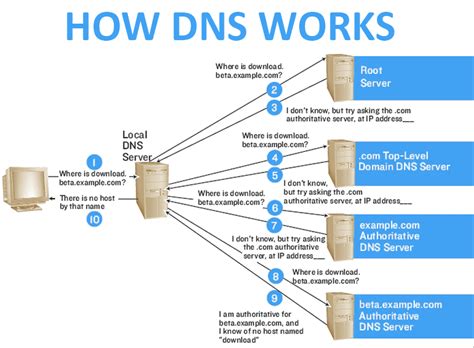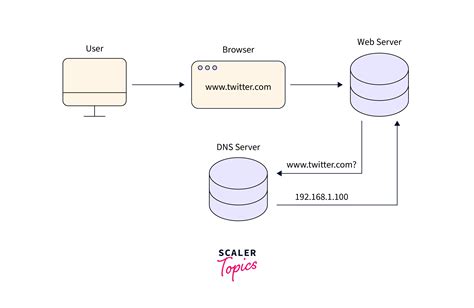Are you interested in exploring the intricate world of networking and expanding your knowledge on server administration? Look no further! In this tutorial, we will walk you through the process of setting up your very own DNS environment on a Linux system. DNS, which stands for Domain Name System, plays a crucial role in translating user-friendly domain names into IP addresses that computers can understand.
By creating your own DNS server, you will gain valuable insights into how this fundamental technology works, empower yourself with greater control over your network, and even potentially improve the speed and performance of your internet connection. Get ready to embark on an exciting journey where you will learn the ins and outs of DNS configuration, zone files, record types, and much more.
In this step-by-step tutorial, we will guide you through the entire process in a clear and concise manner, ensuring that even beginners can follow along easily. We will provide explanations and examples, empowering you to grasp the concepts behind DNS and implement them on your Linux environment. No prior experience is necessary, as we will start from the basics and gradually build up your knowledge.
An Overview of Domain Name System Servers

The domain name system (DNS) is a critical component of the internet, acting as a hierarchical and decentralized naming system. DNS servers play a vital role in translating human-readable domain names into machine-readable IP addresses. By understanding the fundamentals of DNS servers, you can better grasp how internet traffic is routed and how domain names are resolved to their corresponding IP addresses.
DNS servers function as the backbone of the internet, providing a directory service that associates domain names with IP addresses. This enables users to navigate the internet using familiar domain names, such as google.com or amazon.com, rather than having to remember and type in the corresponding IP addresses.
- Hierarchy: DNS servers are organized in a hierarchical structure, with different levels of authoritative servers responsible for different domains. At the top of the hierarchy are the root servers, followed by top-level domain (TLD) servers and then domain-specific servers.
- Resolution Process: When a user enters a domain name in their browser or application, the DNS resolution process begins. The local DNS resolver first checks its cache for a previously resolved IP address. If it doesn't find a match, it queries the authoritative DNS servers in a recursive manner until it obtains the IP address for the given domain name.
- Types of DNS Servers: DNS servers can be categorized into various types, including authoritative servers, recursive servers, caching servers, and forwarders. Authoritative servers have the final say on the IP addresses associated with a domain, while recursive servers handle the resolution process on behalf of clients.
- DNS Records: DNS servers store various types of records that contain essential information about a domain. Common DNS record types include A records (IPv4 address), AAAA records (IPv6 address), MX records (mail exchange), and NS records (name server).
By gaining a better understanding of DNS servers and how they function within the internet's infrastructure, you can enhance your knowledge of networking and troubleshooting, which can be valuable for various IT professionals, system administrators, and network engineers.
Benefits of Implementing a Name Resolution System on a Linux-Based Operating System
In this section, we will explore the advantages and benefits of setting up a Domain Name System (DNS) server on a Linux platform. By leveraging the power of a Linux-based DNS server, organizations and individuals can enhance their network infrastructure, improve website performance, increase security, and optimize resource allocation.
| Improved Network Performance | The implementation of a DNS server on a Linux system can lead to enhanced network performance by reducing the time required to resolve domain names. By caching DNS records locally, the server can quickly provide IP addresses for frequently accessed websites, resulting in faster loading times and improved user experience. |
| Enhanced Website Accessibility | With a Linux-based DNS server, website administrators have greater control over the domain names associated with their web properties. By managing DNS records directly through the server, they can quickly update IP addresses, create subdomains, and implement redirects, ensuring seamless accessibility to their websites. |
| Increased Network Security | Implementing a DNS server on a Linux platform enhances network security by allowing administrators to set up robust firewall rules, implement filtering and blocking, and restrict access based on IP addresses or domain names. By centralizing DNS management, potential security loopholes can be identified and mitigated more effectively. |
| Efficient Resource Allocation | A Linux-based DNS server enables efficient resource allocation within a network infrastructure. By resolving domain names locally, the server reduces the reliance on external DNS services, mitigating the risk of service disruptions and improving overall network stability. Additionally, administrators can prioritize specific servers or load balancers to optimize resource distribution. |
By leveraging the advantages provided by setting up a DNS server on a Linux-based operating system, organizations and individuals can optimize their network performance, enhance website accessibility, bolster network security, and streamline resource allocation. Investing time and effort into implementing a DNS server on a Linux platform can lead to significant improvements in overall network infrastructure and user experience.
Configuring DNS Zones and Records on Linux DNS Server

In this section, we will explore the process of configuring DNS zones and records on a Linux DNS server. By defining zones and creating records, you can establish a hierarchical structure for your domain names and map them to corresponding IP addresses. This ensures that your DNS server can efficiently resolve queries and provide accurate responses to clients.
Firstly, let's understand the concept of DNS zones. A DNS zone represents a portion of the DNS namespace, and it can contain multiple types of resource records that define various aspects of the domain. By defining separate zones, you can manage different areas of your domain independently and delegate authority to different DNS servers.
To configure a DNS zone, you need to define the zone name and specify the authoritative name servers responsible for maintaining and serving the zone. Additionally, you can set the Time-to-Live (TTL) value, which determines how long other DNS servers can cache the records from the zone.
Once the DNS zone is set up, you can proceed to create different types of DNS records within the zone. These records provide crucial information such as mapping domain names to IP addresses (A records), defining mail servers (MX records), establishing aliases (CNAME records), and more. By carefully configuring these records, you can ensure smooth and accurate DNS resolution for your network.
It's important to note that managing DNS zones and records requires a thorough understanding of DNS concepts and the specific requirements of your network. With this knowledge in hand, you can confidently configure the DNS server on your Linux system and optimize it for efficient name resolution.
Setup Your Own DNS Server on Ubuntu Server
Setup Your Own DNS Server on Ubuntu Server by Ripon4You 5,798 views 11 months ago 7 minutes, 38 seconds
DNS in Linux for the Absolute Beginners!
DNS in Linux for the Absolute Beginners! by KodeKloud 88,385 views 3 years ago 14 minutes, 26 seconds
FAQ
What is a DNS server and why do I need one?
A DNS server stands for Domain Name System server, and it translates domain names (like google.com) into IP addresses (like 172.217.4.110). You need a DNS server to browse the internet and access websites by their domain names instead of remembering their IP addresses.
Can I set up a DNS server on my Linux machine?
Yes, you can set up a DNS server on your Linux machine. Linux operating systems provide the necessary tools and services to configure and run a DNS server.
What are the steps to set up a DNS server on Linux?
To set up a DNS server on Linux, you need to install a DNS server software, configure it with your desired domain names and IP addresses, set up DNS zone files, configure DNS settings for your network, and start and test the DNS server to ensure its functionality.
Which DNS server software should I use on Linux?
There are several DNS server software options available for Linux, including BIND (Berkeley Internet Name Domain), NSD (Name Server Daemon), and PowerDNS. The choice of DNS server software depends on your specific requirements and preferences.
Are there any security considerations when setting up a DNS server on Linux?
Yes, security is an important aspect when setting up a DNS server. It is crucial to properly configure access controls, enable secure communication protocols (such as DNSSEC), regularly update the DNS server software, and monitor the server for any suspicious activity to ensure the security and integrity of your DNS infrastructure.
What is DNS and why is it important?
DNS stands for Domain Name System, and it is a system that translates domain names into IP addresses. It is important because it allows users to access websites and services by using human-readable domain names instead of remembering the numerical IP addresses.
What operating system is required for setting up a DNS server?
The guide is specific to setting up a DNS server on Linux. Therefore, any Linux distribution can be used, such as Ubuntu, CentOS, Fedora, etc.




